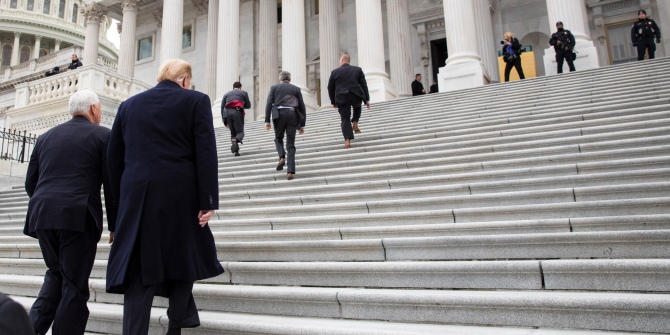 With less than two weeks until the US elections, Joe Biden continues to cling to a healthy lead over Donald Trump. Yet as early voting gets underway, Democrats are warning about complacency, and both sides are gearing up for a post-election fight if the results are close. In this Q&A, Thomas Gift examines what’s in store for the final leg of the race, which battleground states could be pivotal on Election Day, and the controversy that could ensue if the courts get involved with the results.
With less than two weeks until the US elections, Joe Biden continues to cling to a healthy lead over Donald Trump. Yet as early voting gets underway, Democrats are warning about complacency, and both sides are gearing up for a post-election fight if the results are close. In this Q&A, Thomas Gift examines what’s in store for the final leg of the race, which battleground states could be pivotal on Election Day, and the controversy that could ensue if the courts get involved with the results.
Former Vice President Joe Biden holds a comfortable lead in the national polls, but some Democratic leaders are warning voters against complacency. How should we interpret these calls?
Democrats have fretted about complacency for a while, an almost inevitable byproduct of Biden holding a sizable lead. The concern for Democrats, of course, is that if enough voters feel like a Biden win is a foregone conclusion, some might stay home on Election Day. Less appreciated, however, is that Biden’s warning may reflect concern about an “enthusiasm gap.” Even if Trump trails in the national polls by 8 to 10 percentage points, data indicate there are more Republicans extremely excited about casting their ballot for the president than there are Democrats extremely excited about voting for Biden. Biden doesn’t excite the liberal base as much as another candidate from the Democratic primaries might have. So his challenge remains a familiar one: how to mobilize turnout when many rank-and-file Democrats lack enthusiasm for his candidacy.
Trump will be throwing everything he has at Biden in the last couple of weeks before the election. What line of attack is most likely to be effective?
Trump’s team continues to maintain that, if elected, Biden would be a “Trojan horse” for the far left. Most voters don’t see Biden as having an aggressive left-wing agenda, and for good reason—he’s an institutionalist and a relative moderate. But what Biden’s team misses is that the worry isn’t that Biden himself would drive his party hard to the left. It’s that he’d be unable to stand up to forces tugging him in that direction. A case in point is his recent refusal to categorically rule out that he would push to add more justices to the Supreme Court. Democratic voters chose Biden for a reason: because he promised moderation and a return to “normal” politics in Washington. If Biden can reassure Americans that’s how he’d govern, he has a better chance of winning over Republican-leaners who are disillusioned with Trump, but need extra convincing to vote Democrat.
Biden’s lead in the polls is larger nationally than in many swing states. Are there any particular states you’ll be watching closely on election night that could be a bellwether?
Conventional wisdom is that Trump’s path to victory is narrower than Biden’s. Trump’s best chance in 2020 is most likely to duplicate the success he had in 2016, when he narrowly edged out Hillary Clinton in key battlegrounds like Florida, Wisconsin, Ohio, and North Carolina. For Trump, the problem is that many of these states are looking, if not out of reach, then definitely uphill battles this year. One state I will follow closely is Pennsylvania. According to 538, polls have Biden with about a 7 percentage point lead there. In many ways, it’s a microcosm of the ostensible shift away from Trump—not just among moderates in the suburbs of Philadelphia or Pittsburgh, but in a number of small towns in the central part of the state, which have been hurt by unemployment and other challenges associated with COVID-19.

“GOTV Rally at Michigan State Fairgrounds – Detroit, MI – October 16, 2020” by Joe Biden is licensed under CC BY NC SA 2.0
Many experts are speculating that this election could get decided by the courts. How likely is that scenario?
If Biden can maintain his hefty lead going into the November 3rd election, the courts will be a moot point. Still, both sides will be lawyered up and ready for a close outcome. That’s especially true because this year’s election logistics are more complex than what we’ve seen in the past, with the overwhelming number of mail-in ballots in the wake of the pandemic. One reason why Trump indicated that he wanted Amy Coney Barrett confirmed on the Supreme Court before November 3rd is that she’d be eligible to cast a vote in any election-related case that might come before the Court. Obviously, when the Supreme Court rendered a verdict in Bush v. Gore in 2000, that was divisive. But the country is at a whole new level of polarization now. So if this election is decided by the courts, it could leave an even larger tear in America’s political fabric.
Already, sizable percentages of Americans have cast their ballots early, including by mail. How might this affect the election?
Even participation in mail-in balloting now is polarized by party. Many more Biden voters are expected to cast their ballots through mail than Trump voters. Part of that is due to Trump downplaying the risks to voting in-person and suggesting, without evidence, that mail-in balloting could be susceptible to widespread fraud. Regardless, there’s no doubt that mail-in ballots will be pivotal in swing states. That adds another layer of complexity both to making predictions about who will win and about whether Trump will contest the results if he loses by a razor-thin margin. In August, The Washington Post reported that, in the primaries, roughly half a million mail-in ballots across 23 states were disqualified for technical reasons. So worst-case scenario is this becomes the 2020 version of hanging chads—and we can only imagine the fallout from that.
- These remarks are based in part on an interview by Thomas Gift on CNN Newsroom on October 19, 2020.
Please read our comments policy before commenting.
Note: This article gives the views of the author, and not the position of USAPP – American Politics and Policy, nor the London School of Economics.
Shortened URL for this post: https://bit.ly/2Tgzx3q
 Thomas Gift – UCL
Thomas Gift – UCL
Thomas Gift is Associate Professor of Political Science at UCL, where he is director of the Centre on US Politics (CUSP). He is also a Visiting Fellow at the LSE US Centre and a Fellow in Residence at the University of Oxford’s Rothermere American Institute.






